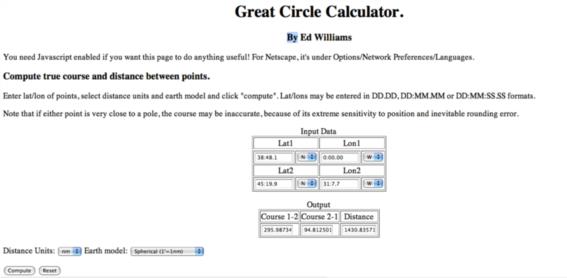
NavList:
A Community Devoted to the Preservation and Practice of Celestial Navigation and Other Methods of Traditional Wayfinding
From: Greg Rudzinski
Date: 2012 Sep 15, 12:55 -0700
Frank,
I see now the spherical setting in the William's calculator which gets the right distance (see attachment). I'm not sure how the approximation is to be applied. To the calculated result or the observed sextant reading ?
Greg Rudzinski
[NavList] Re: Angular Distance Between Stars
From: Greg Rudzinski
Date: 15 Sep 2012 12:28
Frank,
When the standard sin cos formula is used then 90*-Hc = my sextant reading plus the refraction approximation. I'm thinking that great circle calculators are not so good for this application.
Vega to Deneb angular distance by Tamaya 7x35 mm scope = 23* 50.4' (0.0' I.C.)
Lat 34* 10.4' N
Lon 119* 13.8' W
Temp 75*
Press 29.98 in.
Hc Vega 83*
Hc Deneb 59*
approximate refraction correction + 0.5'
Greg Rudzinski
[NavList] Re: Angular Distance Between Stars
From: Greg Rudzinski
Date: 15 Sep 2012 12:04
Frank,
When using the William's GC calculator I'm getting quite a spread of results depending on the spheroid setting. What should be entered for the radius and flattening ratio to get correct star to star distances. My first effort measuring between Vega and Deneb was 5' out so something is very wrong here :(
Greg
[NavList] Re: Angular Distance Between Stars
From: Frank Reed
Date: 14 Sep 2012 09:45
You can use any great circle distance calculator that allows you to enter latitude and longitude. Here's one:
http://williams.best.vwh.net/gccalc.htm
(for "Earth model", select spherical). Since this is a javascript calculator, you can view the source and modify it to suit your needs if you feel like messing around in code. Just enter SHA (or GHA) for longitude and Dec for latitude.
Great circle distance doesn't depend on the coordinate system, so you could also enter azimuths and altitudes instead of SHAs and declinations. This is handy if you want the refracted distance. If you use a standard planetarium software app like Stellarium, you can set it for some location and time and read out the altitudes either true or refracted and then enter them into any great circle distance calculator.
I've said this recently so I apologize for repeating, but you can get the refracted distance for any pair of stars when both altitudes are above 45 degrees to a good approximation by decreasing the true great cirlce distance by 1/3000 (a tenth of a minute of arc for every 5 degrees of distance).
-FER
----------------------------------------------------------------
NavList message boards and member settings: www.fer3.com/NavList
Members may optionally receive posts by email.
To cancel email delivery, send a message to NoMail[at]fer3.com
----------------------------------------------------------------







